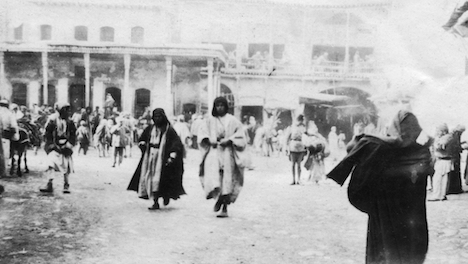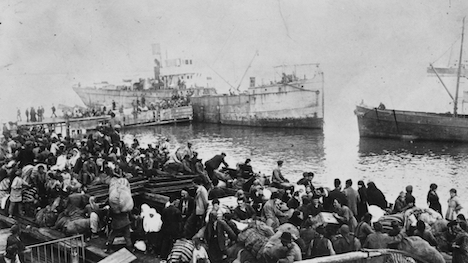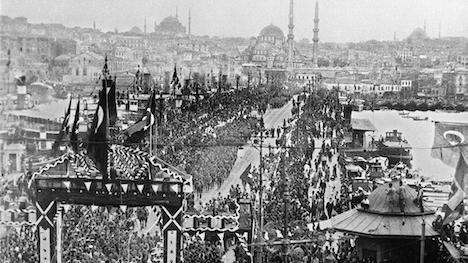|

|
Remembering World War I in the Middle East
 Print This Print This
By Kristian Coates Ulrichsen | Al Jazeera
Al Jazeera
Tuesday, Nov 13, 2018
 |
| Turkish popular print: Mustafa Kemal Ataturk attacking the Greeks in Sekariae in 1922 [Getty Images]
|
Signs of World War I are everywhere and nowhere in the Middle East.
Overlain by subsequent conflicts and decades of bitter contestation, the legacies of the wartime experience continue to reverberate long after the conflict passed into history in Europe. With the Middle East in the throes of renewed political turmoil and having experienced decades of regional and international crises, many deriving from the decisions taken after the World War I, the complicated legacies of the war may not immediately be apparent but are nonetheless highly relevant.
A parallel may be drawn with the divided Europe up until 1989, where the ramifications of the World War II remained highly visible across multiple generations and made it difficult to establish historical distance from events whose legacy continued to resonate decades after.
The fighting in the Middle Eastern theatres of the war - Egypt, Palestine, Lebanon, Syria, modern-day Iraq, and Turkey - came to an end with the Armistice of Mudros signed by British and Ottoman officials on a warship in the Aegean Sea on October 30,1918.
In his post-war memoirs, Britain's acting Civil Commissioner in Baghdad, Arnold Wilson, recalled how the looming end of hostilities led him to urge "every effort … to score as heavily as possible on the Tigris before the whistle blew".
Thus, the city of Mosul, widely (and correctly) believed to be in the heartland of the richest oilfields in Mesopotamia, was occupied on November 10, 1918. This may have been one day before the end of the war in Europe, but it was 11 days after the Armistice of Mudros and it signalled a start of the clash of competing visions for translating wartime gains into peacetime.
 |
| Busy square in Mosul, Mesopotamia. The region, formerly part of the Turkish Ottoman Empire, came under British military control in October 1918 [Getty Images] |
While the Treaty of Versailles signed with a vanquished Germany on June 28, 1919 (the fifth anniversary of the assassination in Sarajevo of Archduke Franz Ferdinand that triggered the slide to war in 1914) is by far the most well-known outcome of the post-war peace conferences, four other treaties also were formulated to address different regional aspects of the conflict.
These were the Treaty of Saint-Germain with Austria on September 10, 1919, the Treaty of Neuilly with Bulgaria on 27 November 1919, the Treaty of Trianon on June 4, 1920 with Hungary, and the Treaty of Sevres with the Ottoman Empire on August 10, 1920, which subsequently was superseded by the Treaty of Lausanne made on June 24, 1923 with the new Republic of Turkey.
The Treaty of Sevres covered the partitioning of the Ottoman Empire and determining the nature of the post-war political entities that took its place. In addition to raising Kurdish and Armenian hopes that some form of conditional independence might be granted to them, the treaty imposed swingeing political and financial terms on Istanbul.
France, Italy, and Greece were all given zones of influence in southern, western, and central Anatolia while Greece also made large territorial gains in Thrace. These effectively removed the Ottoman Empire from the European landmass, while Istanbul itself remained under the direct British, French, and Italian occupation that had started on November 12, 1918.
It took more than 16 months of tortuous negotiation for the Treaty of Sevres to come to fruition. Following the initial meetings in Paris in the spring and summer of 1919, the negotiations continued into 1920 with substantive meetings at the Conference of London (February 12-24) and the San Remo Conference (April 19-26). In addition to formulating a punitive treaty on the rump of the Ottoman Empire, the victorious powers also faced the task of reconciling their divergent wartime objectives and agreements.
These included the vague wartime promises made between 1915 and 1917 - the Hussein-McMahon correspondence of 1915-16, the Sykes-Picot Agreement in 1916, and the Balfour Declaration of 1917 - which planted the seeds of resentment and conflict once their full extent, and their imperialist and contradictory nature, was revealed in 1918.
Against the backdrop of rising nationalist movements across the Middle East and an assertive Turkish military and nationalist alliance sweeping away the final vestiges of Ottoman rule, the wartime allies attempted to maintain political control by devising and distributing a system of mandates for administering the region.
 |
| Turkish general and statesman Mustafa Kemal Ataturk reviewing his troops during the war of independence against Greece [Getty Images] |
The result was the formation of the boundaries of the modern Middle East, albeit in the face of concerted public and political opposition from local populaces. Yet, the ink on the Treaty of Sevres was hardly dry before it was rendered obsolete by radical shifts in the situation on the ground.
Already in 1919, Britain's position in the Middle East was shaken by an uprising in Egypt against the continuation of British wartime powers and a nationwide anti-British rebellion in Iraq in 1920. Syria and Lebanon, meanwhile, saw fierce confrontation between local and international plans for the post-war settlement, which led to a falling-out between erstwhile allies Britain and France, sharp clashes with French troops sent to occupy Syria, and, ultimately, the embedding of Arabism at the core of Syrian national identity and the establishment of Hashemite Kingdoms in Iraq and Jordan rather than in Syria itself.
In what remained of the Ottoman Empire, a Turkish National Movement orchestrated by the victor of Gallipoli, Mustapha Kemal Ataturk, grew from strength to strength as it capitalised on feelings of anger and humiliation and organised the political and military resistance to the occupation. What began as a loose umbrella of nationalist groups across the country quickly swelled into a unifying national movement against the occupying powers.
A series of congresses were convened in the second half of 1919 at which delegates from all over Turkey drew up a political manifesto. In March 1920, in the run-up to the final deliberations of the Treaty of Sevres, the Turkish National Movement formally split with the Ottoman state and established its own parliament, the Grand National Assembly, in Ankara. It met for the first time on April 23, just as the allied powers were meeting in San Remo to draw up the system of mandates for the Middle East.
Relations between the Turkish National Movement and the Ottoman Government broke down irretrievably in October 1920. By that stage, French, Greek, and Armenian forces were all engaged with units directed by the Grand National Assembly in separate parts of Turkey.
Kemalist forces overwhelmed Armenian units in November 1920 and, in March 1921, Turkey signed the Treaty of Moscow with the Soviet Union that incorporated the rump of Armenia as a Soviet republic and returned two "lost" Ottoman provinces of Kars and Ardahan to Turkey. Allied support for Kurdish independence slipped away in the face of Turkish gains.
French forces withdrew from the southern Turkish region of Cilicia in 1921 following a gruelling conflict with Turkish nationalists that cost France heavily in lives and money. Greek troops fighting to realise Eleftherios Venizelos's "Megali Idea" (Big Idea) initially pushed inland through Anatolia towards Ankara in 1921. However, Kemal's counterattack in August 1922 shattered the Greek army and pushed them back into the coastal city of Smyrna (today's Izmir).
Smyrna was taken in September and its Greek and Armenian communities forced to flee as representatives of the great powers looked on powerless to intervene.
 |
| Thousands of local Greeks fleeing by sea from Smyrna, Turkey, driven out by the armies of Mustafa Kemal Ataturk [Getty Images] |
Aside from settling the modern boundaries of Turkey and Greece (and in the process unleashing a humanitarian catastrophe as hundreds of thousands of Greeks and Turks were forcibly exchanged), the resolution of the Greco-Turkish war had another consequence. It led to the political downfall of Britain's wartime leader, David Lloyd George, whose Liberal party remained in its post-1915 alliance with the Conservatives.
This occurred after the "Chanak Crisis" in October 1922. The resounding defeat of Greek forces in Anatolia opened the way for Kemal to march north towards Istanbul. To prevent this, Lloyd George's government in London called on the British Empire and its allies to hold the line at Chanak, on the Asiatic shore of the Dardanelles.
However, in a humiliating development for Britain, only New Zealand supported the call for bellicosity, while France and Italy both refused to support Lloyd George. As criticism of Lloyd George mounted, his Conservative coalition partners voted to withdraw from the government, removing Lloyd George as prime minister and deposing his Liberal Party permanently from office.
Lloyd George's sudden departure from office was the last decisive break with the wartime era. Recognising that the Treaty of Sevres was unenforceable, it was replaced by the Treaty of Lausanne in July 1923.
The treaty extended international recognition of Turkish sovereignty in response to the abandonment of territorial claims for all non-Turkish regions of the Ottoman Empire. Allied forces also ended their military occupation of Istanbul (in September 1923) and Ankara was declared the new capital of the Republic of Turkey on October 29, still celebrated today as Turkey's national day.
In March 1924, the new Turkish government headed by Ataturk formally abolished the caliphate, the last remaining Ottoman symbol, and embarked upon a process of reshaping Turkey into a modern, secular, European nation-state.
World War I thus was pivotal to the creation of the modern Middle East. It hastened the demise of the Ottoman Empire and paved the way for the emergence of a state-system (albeit initially under mandatory rule) that remains largely in place today.
The entire political landscape of the region was reshaped as the legacy of the war sapped the ability of imperial "outsiders" to dominate and influence events as nationalist groups succeeded in mobilising mass movements around distinctly national identities. Issues such as the Sykes-Picot Agreement and the Balfour Declaration remain spoken about as if they refer to contemporary controversies, and it was no accident that when militants of the Islamic State of Iraq and the Levant (ISIL, or ISIS) bulldozed the border post between Syria and Iraq in 2014, they claimed they were dismantling the Western boundaries imposed by and after the war.
 |
| Turkish troops of the Iron Division march across the Galata Bridge into Constantinople, Turkey, in October 1923 to mark the end of its occupation by foreign allies [AP Photo] |
A century on, Armistice of Mudros, and the end of the war, more generally, will be marked for different reasons in Turkey than in Europe. The way Gallipoli catapulted Ataturk to national status cemented his subsequent role as the builder of the modern Turkish nation.
However, over the past 15 years, the nature of the Turkish state he put in place has been superseded by the domination of President Recep Tayyip Erdogan, who this year surpasses Ataturk's longevity in power. After the war and the turbulence of the immediate post-war years, the ties between the erstwhile foes repaired rapidly, epitomised by the moving words attributed to Ataturk on a war memorial at Gallipoli.
As Ataturk oversaw a programme of social modernisation, he moved Turkey decisively towards Europe and away from the Middle East in a shift that, again, has only started to reverse in recent years under Erdogan.
For Europeans, World War I will remain dominated by the battles on the Western Front - Verdun for the French, the Somme and Passchendaele for the British, the Kaiser's Great Offensive for the Germans - that have been seared into historical memory and national mythmaking.
And yet, the role of the war in shaping and creating the state-system of the modern Middle East merits much more than an afterthought when the ceremonies to mark the end of the war are commemorated on Sunday.
While the modern bedrock of European relations with Turkey was cemented after World War II, when hundreds of thousands of Turks migrated to post-war Germany and Turkey's strategic orientation was enshrined in NATO, it was the settlement of the earlier war that set Turkey on its trajectory and gave it the hybrid identity it retains today.
Source URL
|
 Print This Print This

|
If you appreciated this article, please consider making a donation to Axis of Logic.
We do not use commercial advertising or corporate funding. We depend solely upon you,
the reader, to continue providing quality news and opinion on world affairs. Donate here
|
 |
World News

|

